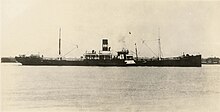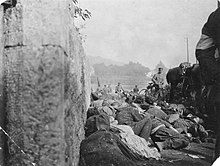War crimes in World War I
Even so, both the decisions to commit, and to refuse to court-martial, the perpetrators of World War I crimes was motivated by what American Civil War historian Thomas Lowry has termed "the European tradition … that to victors belong the spoils - the losers could expect pillage and plunder",[1] and that enemy civilians are "grist for the mills of more hardheaded conquerors such as Genghis Khan, Tamerlane, and Ivan the Terrible.
On 17 August 1914, in Šabac, 120 residents—mostly women, children and old men—were shot and buried in a churchyard by Austro-Hungarian troops on the orders of Feldmarschall-Leutnant Kasimir von Lütgendorf.
[7] A pit was later discovered in the village of Lešnica containing 109 dead peasants who were "bound together with a rope and encircled by wire"; they had been shot and immediately buried, even with some still alive.
[11] During the war, Austro-Hungarian officers in Serbia ordered troops to "exterminate and burn everything that is Serbian", and hangings and mass shootings were everyday occurrences.
[20] Serbs also suffered from famine; General Franz Conrad von Hötzendorf gave orders for Serbia's resources be "squeezed dry" regardless of the consequences for the population.
[21] Looting by occupying soldiers,[22] combined with the food exporting policies of Austria and Germany,[23] caused mass starvation, leading to the deaths of 8,000 Serbians during the winter of 1916.
[21] According to a Red Cross report dated 1 February 1918, by the end of 1917, there were 206,500 prisoners of war and internees from Serbia in Austro-Hungarian and German camps.
The shooting was reported to the media by American citizens who were on board the Nicosian, a British freighter loaded with war supplies, which was stopped by U-27 just minutes before the incident.
[31] Sally Marks argued that the German accounts of a hunger blockade are a "myth", as Germany did not face the starvation level of Belgium and the regions of Poland and northern France that it occupied.
[43] In the UK, Labour Party member and anti-war activist Robert Smillie issued a statement in June 1919 condemning continuation of the blockade, claiming 100,000 German civilians had died as a result.
[44][45] Before a pervasive climate among the Australian guards of excessive cruelty and unnecessary brutality led to an international diplomatic incident, the dismissal with disgrace of their commanding officer, Captain G.E.
Hawkes, from the Australian Army, and its permanent closure in 1916, the Torrens Island Concentration Camp in South Australia was used to hold both Central Powers POWs and civilian internees.
Another 80,000 were not imprisoned but were registered as "enemy aliens" and obliged to regularly report to the police and were required to carry identifying documents at all times or suffer punitive consequences.
Occurring at the conclusion of the Sinai and Palestine campaign of World War I, Allied occupational forces in the region, in particular Australian and New Zealand troops, gradually grew frustrated over being subject to petty theft and occasional murders by local Arabs without redress.
[55] The Documents relatifs aux violations des Conventions de La Haye et du Droit international, commis de 1915–1918 par les Bulgares en Serbie occupée, a report covering alleged atrocities committed in Serbia, published after the war, stated that ‘anyone unwilling to submit him or herself to the occupiers and become Bulgarian was tortured, raped, interned, and killed in particularly gruesome manners, some of which recorded photographically'.
The raid was in violation of the ninth section of the 1907 Hague Convention which prohibited naval bombardments of undefended towns without warning,[62] because only Hartlepool was protected by shore batteries.
[72] British propaganda dramatising the Rape of Belgium attracted much attention in the United States, while Berlin said it was both lawful and necessary because of the threat of franc-tireurs like those in France in 1870.
Germany intended to starve Britain as well, but unlike the British, prize rules, which were codified under the 1907 Hague Convention—such as those that required commerce raiders to warn their targets and allow time for the crew to board lifeboats—were disregarded and commercial vessels were sunk regardless of nationality, cargo, or destination.
This outraged the U.S. public, prompting the U.S. to break diplomatic relations with Germany two days later, and, along with the Zimmermann Telegram, led the U.S. entry into the war two months later on the side of the Allied Powers.
[82] The Canadian hospital ship HMHS Llandovery Castle was torpedoed by the German submarine SM U-86 on 27 June 1918 in violation of international law.
[86][91] The government of Turkey has consistently denied the genocide, arguing that those who died were victims of inter-ethnic fighting, famine, or disease during World War I; these claims are rejected by most historians.
[92] Other ethnic groups were also attacked by the Ottoman Empire during this period, including Assyrians and Greeks, and some scholars consider those events different parts of the same policy of extermination.
[98] As such, in March 1917 the population of Ayvalık, a town of c. 30,000 inhabitants on the Aegean coast, was forcibly deported to the interior of Anatolia under the orders of German General Liman von Sanders.
[114] Halil Kut and Djevdet Bey ordered the murder of Armenian and Syriac soldiers serving in the Ottoman army, and several hundred were killed.
[119] Although many Kurds were loyal to the empire (with some even supporting the persecution of Christian minorities by the CUP), Turkish authorities nevertheless feared the possibility that they would collaborate with Armenians and Russians to establish their own Kurdish state.
[124] That same month – on the orders of Djemal Pasha – tens of thousands of people were deported from Jaffa, an action that was accompanied by severe violence, starvation, theft, persecution and abuse.
[145] In time, chemical weapons were deployed by all major belligerents throughout the war, inflicting approximately 500k-1.3 million casualties, but relatively few fatalities: About 26–90,000 in total.
[151] On 24 May 1915, on the initiative of Russia, the Triple Entente—Russia, France, and the United Kingdom—issued a declaration condemning the Ottomans for committing "crimes […] against humanity and civilization" against the Armenians, threatening to hold the perpetrators accountable.
[157] Polish-Jewish lawyer Raphael Lemkin, who coined the term genocide in 1944, became interested in the prosecution of war crimes after reading about the 1921 trial of Soghomon Tehlirian for the assassination of Talaat Pasha.
As stated by Coupland and Leins, "it was fostered in part by a 1918 appeal in which the International Committee of the Red Cross (ICRC) described the use of poisonous gas against soldiers as a barbarous invention which science is bringing to perfection".















